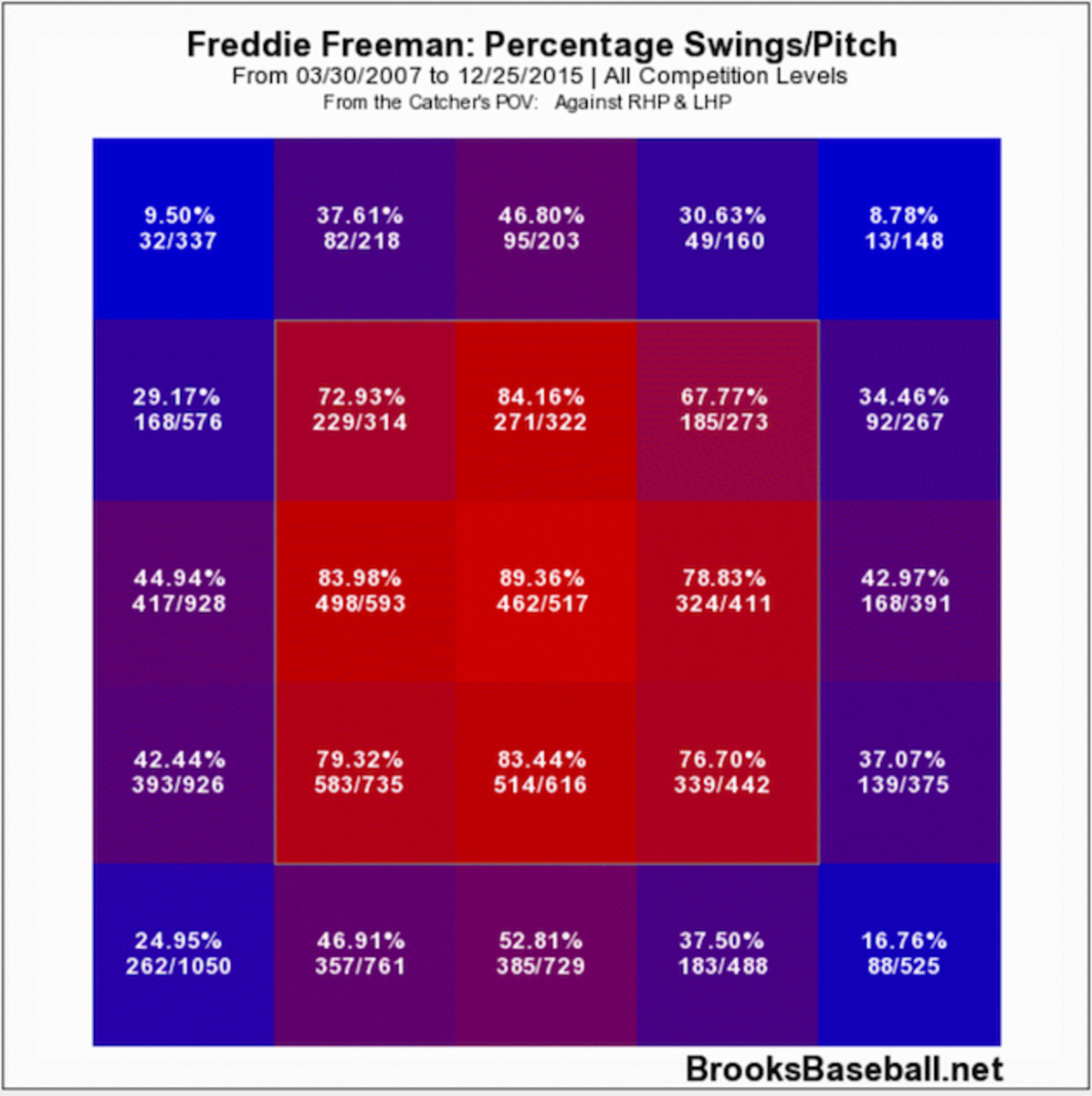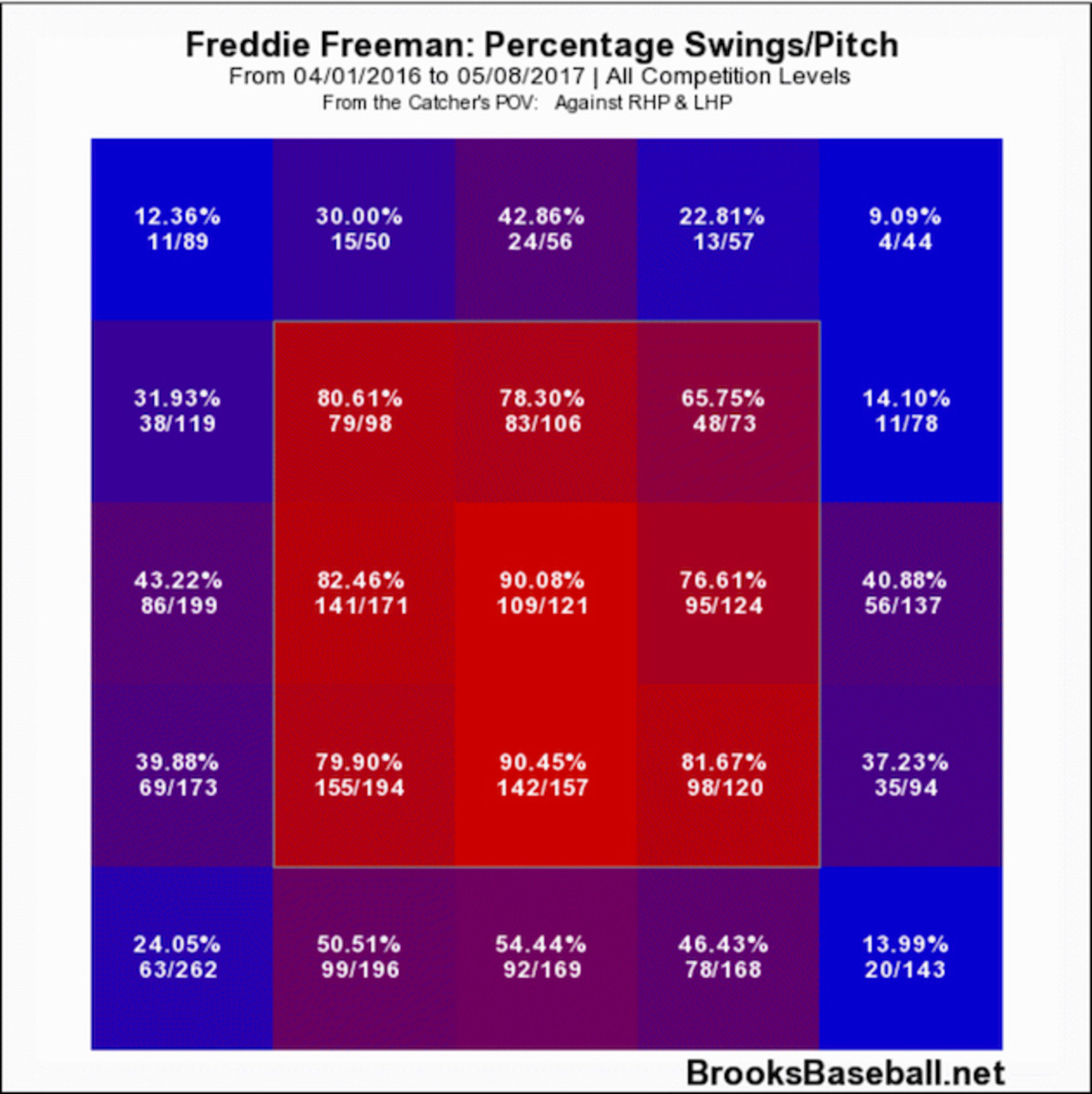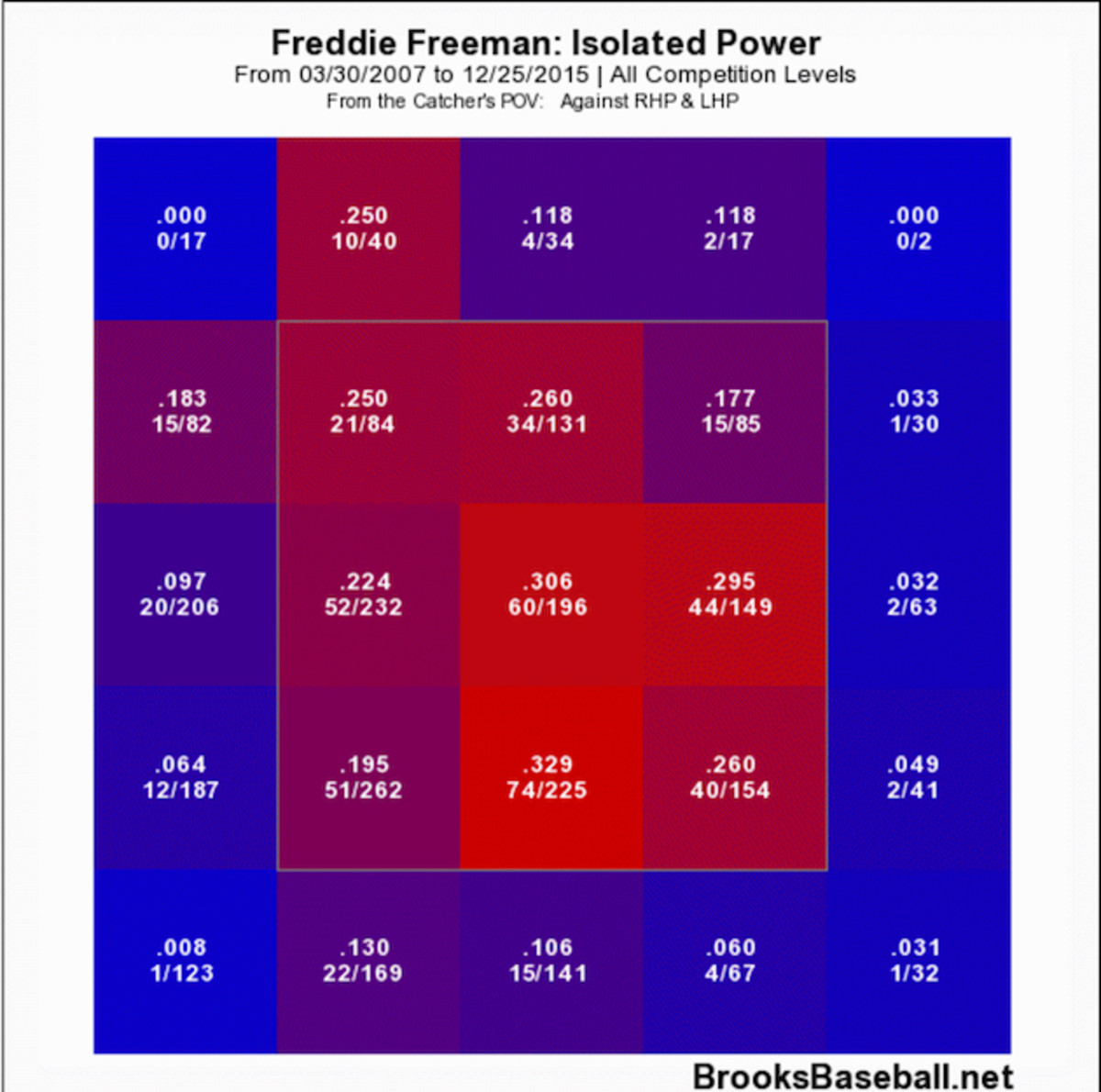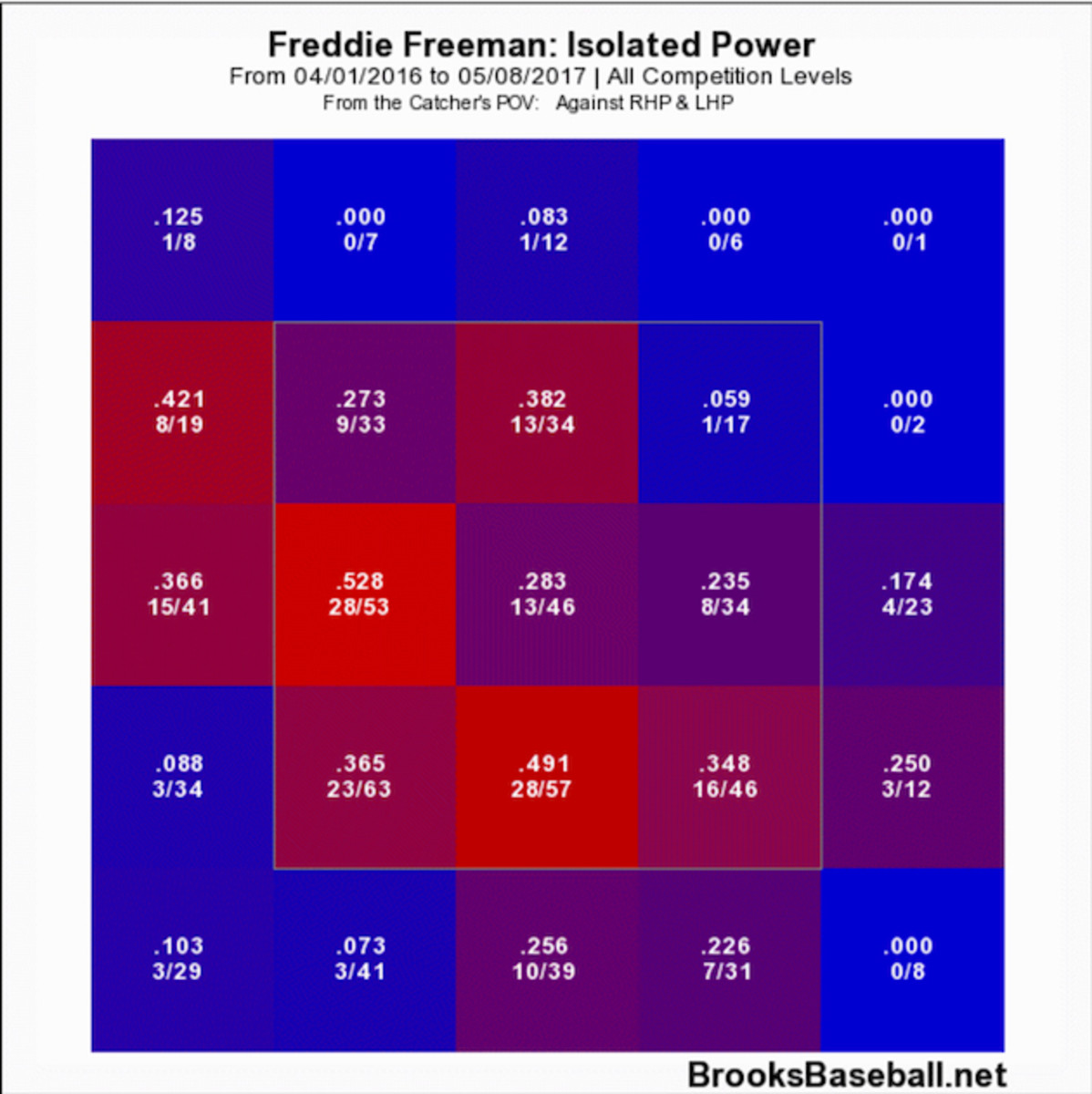How Freddie Freeman went from a dependable player into one of the game's elite hitters

At the start of the 2016 season, the league had what seemed like a clear read on Atlanta Braves first baseman Freddie Freeman. From 2011 through 2015, Freeman’s first four full seasons in the majors, he was a great hitter and an on-base machine with modest power. In those four seasons, he slashed .286/.368/.467, with per-year averages of 21 homers, 32 doubles and 85 RBI. Those years covered Freeman’s early and mid-20s, with 2016 set to be his age-26 season. There was little reason to expect him to develop into a top-flight power hitter except his growth into his physical prime. Despite his age, he already had more than 3,000 plate appearances under his belt, and four full seasons of being the same great hitter, but not that powerful.
Freeman churned out line drives with extreme regularity, posting the second-highest line-drive rate in the majors across those four years, trailing only Joey Votto. Something changed in Freeman last year, though. He still stroked line drives with the best of them, posting a 29.1% line-drive rate, the second-best mark of his career. He significantly cut down on ground balls and increased his fly-ball rate. More than two-fifths of the balls Freeman put in play last year were fly balls, and just shy of one-fifth of those left the yard. The result? He hit 34 homers, besting his previous career high by 11. With 11 homers to his name already this season, Freeman is comfortably on pace to set another career record. No matter where he ends up, he has turned himself into one of the league’s truly elite hitters thanks to his sustainable power surge.
Since the start of last season, there are four players who have cleared the .300/.400/.500 thresholds. They are Mike Trout, Paul Goldschmidt, Freeman and Votto. Freeman leads that group in homers, quite comfortably, with 45. If he manages a couple of extra-base hits in the next few days, he’ll also be the only one of the four with a slugging percentage north of .600. Since the start of last season, there are two players with a weighted runs created plus of better than 160, which means they’ve been 60% more productive than an average player. That duo is Trout and Freeman.
Carl Edwards, Justin Wilson are the types of relievers who will jolt your fantasy teams
Since the start of last season, six players have an fWAR of 8.0 or better. You can probably guess at least two of them. Joining Trout and Freeman are Kris Bryant, Mookie Betts, Corey Seager and Josh Donaldson. Take Freeman out of the equation, and the other five players have combined for six top-three MVP finishes, including three wins (Donaldson in 2015, Trout and Bryant in 2016). No player in the majors has a better isolated slugging percentage, dating back to last season, than Freeman’s .288. It’s not a stretch to say that from Opening Day 2016 through the present day, Freeman has been the best hitter on the planet not named Mike Trout.
It’s clear that the offseason between 2015 and 2016 is a line of demarcation in Freeman’s career. Using that as our dividing point, let’s consider a few factors that help explain Freeman’s rise. One facet of Freeman’s game that is quite striking is that, even though he has maintained a high walk rate over the last two seasons, (12.8% last year, 16.9% so far this year), he’s not a particularly patient hitter. Freeman had a swing rate of 52.5% last year, and he’s at exactly 50% this year. What’s more, he has offered at more than 80% of pitches in the zone both of the last two seasons. Going back to 2011, Freeman’s first full year in the majors, there have been 14 instances of a hitter posting a z-swing rate, the frequency with which a hitter swings at strikes, of 80% or higher. Two of those belong to Freeman, and most of the others are owned by famous free swingers like Josh Hamilton, Delmon Young, Vladimir Guerrero and Carlos Gomez. Unlike those hitters, Freeman will lay spit on pitches out of the zone far more often than not. He’s just not going to wait around, though, if he gets a pitch he likes. That tendency has increased the last two seasons, with great results.
Let’s take a look at this in chart form. The first two are Freeman’s swing rates by zone, courtesy of Brooks Baseball. I’ve separated 2011–2015 Freeman and 2016–2017 Freeman into two separate charts. He was always aggressive when pitches came in the zone, but he has taken that to new heights the last two years, particularly on low strikes.


Even on pitches right down the middle, it’s rare to see a 90% swing rate for any zone over a year and change. Freeman has it in two zones, and four more where he has swung at least 80% of the time. Not only is Freeman more aggressive than he was previously, he’s doing more with the balls he puts in play. Here’s a look at his ISO (a metric designed to measure raw power by subtracting batting average from slugging percentage) by zone, again separated by his pre- and post-power breakout.


In all but one zone, Freeman has an ISO of .235 or better. To give you an idea of just how lethal that is, consider this. Last year, MLB hitters belted 5,610 home runs, the second-most ever in a season. Still, just 27 hitters had an ISO at .235 or higher, and all but two of them, Daniel Murphy and Matt Carpenter, had at least 29 homers. Freeman has been that good in eight of the nine distinct areas in the strike zone laid out by Brooks for seven-plus months of baseball.
The 30: The Astros and Yankees look like the class of the American League
The diversity of Freeman’s home runs, too, shows how futile it can be to attack him in the zone. Below are GIFs of five of his dingers this season. They came on five distinct pitches in four different locations. Whether he’s serving a Brett Cecil knuckle-curve on the outer third into the seats in left-center, or catching up to a letter-high Jeremy Hellickson fastball and drilling it to deep right-center, Freeman is making these pitchers’ lives a nightmare.
Now think about what Freeman can still become. He’s 27 years old, and still might have some more growth in front of him. He does everything you can ask of a hitter, and does it all extremely well. Even though his team might hold him back, Freeman should be in the MVP discussion all season.
Hitters to watch this week
Billy Hamilton, OF, Reds
Hamilton has 19 steals in the Reds 32 games this season. Taking times on base out of the equation, that puts Hamilton on pace for 96 steals, rounding down to the nearest whole number. The last time a player swiped at least 90 bags was in 1988, when Rickey Henderson pilfered 93 of them. The last time a player did it with an OBP as low as Hamilton’s .307 was in 1986, with Vince Coleman stealing 107 bases despite an OBP of .301. There’s no great way to find how many times Coleman reached base via an error or fielder’s choice that season, but he had 201 hits, walks and hits by pitch. Hamilton is on pace for 212. If he can maintain that and pick up the stolen base pace ever so slightly, 100 swipes could be in his sights.
Aaron Altherr, OF, Phillies
Altherr is going to force Pete Mackanin into a tough decision in about a week. Howie Kendrick is expected to return from the DL right around then after a rehab assignment as he works his way back from an oblique injury. Altherr has been starting in Kendrick’s absence, and it’s hard to imagine Mackanin taking him out of the lineup given the way he has swuing the bat. Altherr has started 15 games this season, slashing .333/.415/.561 with two homers, seven doubles, three steals and eight RBI in those contests. He has logged all his time in the outfield, which is true of Kendrick this season, as well. Altherr’s play could force Kendrick back to the infield, most likely to first base. Assuming Altherr remains a regular in the Phillies lineup, he’ll be worth a look in all fantasy formats.
Five years after his four-homer game, Josh Hamilton's playing days may be finished
Carlos Correa, SS, Astros
Correa finally showed signs of breaking out of his season-long funk, going 10-for-28 with a homer, four doubles and three walks last week. That raised his slash line to .263/.336/.412 from .233/.309/.349 before the miniature hot streak. We know Correa is better than this, but it’s understandable for his fantasy owners to be a bit anxious with this following on the heels of his slightly disappointing 2016 season. Still, talent almost always wins out in the end, and we’re talking about a 22-year-old who already has some real MLB success in his past.
Carlos Gonzalez, OF, Rockies
Gonzalez has had some ugly Aprils in his career. It was already statistically his worst month coming into this season, and he only added to that by slashing .216/.283/.341 this April. May hasn’t been any better, with Gonzalez going 1-for-16 with a walk in the first week of the second month of the season. There’s plenty of reason to believe Gonzalez will snap out of this sooner rather than later, but it can’t come a moment too soon for his fantasy owners. Now would also be a good time to check in on how his owner is feeling. Gonzalez is a realistic buy-low target, unlike a Correa-type, whose owner is highly unlikely to sell at any discount.
Orioles-Nationals series
These are two of the best offenses in the majors, even if only one of them, the Nationals, has shown it all season. The Nats entered this version of the Beltway series leading the majors with 194 runs and a .363 wOBA, and second in the league with 50 homers. The Orioles haven’t quite lived up to their mashing ways of the last few seasons, but Manny Machado has eight homers, he and Jonathan Schoop both have wOBAs better than .350, and it’s likely just a matter of time before Chris Davis finds his pop. The Orioles won game one on Monday, 6-4, behind homers from Mark Trumbo, Trey Mancini and Joey Rickard. Bryce Harper, of course, hit his 10th bomb of the season in the game, as well.
Prospect Watch
Yoan Moncada, 2B, White Sox
Yes, we’ve already highlighted Moncada once this year in the Prospect Watch. Yes, it’s just the fourth week of the minor league season. Still, when a player is as hyped as he is and has the sort of week he just had, what are we supposed to do? Ignore it? Pretend like it didn’t happen? Of course we can’t do that. Moncada demands our attention, and he’ll likely be doing so in the majors in the not-too-distant future.
Moncada was named the International League Player of the Week on Monday after he went 11-for-22 with two homers and four RBI for Triple-A Charlotte. His season-long slash line is up to .352/.427/.565, and he has racked up six jacks, three doubles and 11 RBI in 124 plate appearances. This is his first taste of the Triple-A level, but he’s showing that he doesn’t have a whole lot more to prove in the minors. In addition to the eye-popping surface stats, he has struck out less often this year than he did in Double-A ball a season ago. He has also maintained a high walk rate, earning a free pass in more than 12% of his plate appearances.
The White Sox are wisely keeping Moncada in the minors at least until the Super Two deadline passes, which gives them another year of team control over the most prized prospect in baseball. The good news for White Sox fans itching to see just what their team got when it traded Chris Sale to Boston is that the Super Two deadline arrives in about one week. Once it passes, the team will be liable to call up Moncada any day. If he’s still available in your league, and if you’re allowed to add and stash minor leaguers, now is the time to act. No one will sleep on this guy once he’s promoted.
GIF of the Week
Kyle Schwarber isn’t exactly known for his defense but he made an excellent, acrobatic play in the Cubs-Yankees 18-inning marathon last Sunday. It doubled as the first instance of play that likely wouldn’t have been made in any of the first 103 years of Wrigley Field’s existence, with the bullpen mounds complicating Schwarber’s path.
